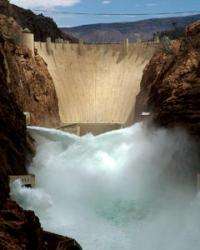Climate change means shortfalls in Colorado River water deliveries

The Colorado River system supplies water to tens of millions of people and millions of acres of farmland, and has never experienced a delivery shortage. But if human-caused climate change continues to make the region drier, scheduled deliveries will be missed 60-90 percent of the time by the middle of this century, according to a pair of climate researchers at Scripps Institution of Oceanography, UC San Diego.
"All water-use planning is based on the idea that the next 100 years will be like the last 100," said Scripps research marine physicist Tim Barnett, a co-author of the report. "We considered the question: Can the river deliver water at the levels currently scheduled if the climate changes as we expect it to. The answer is no."
Even under conservative climate change scenarios, Barnett and Scripps climate researcher David Pierce found that reductions in the runoff that feeds the Colorado River mean that it could short the Southwest of a half-billion cubic meters (400,000 acre feet) of water per year 40 percent of the time by 2025. (An acre foot of water is typically considered adequate to meet the annual water needs of two households.) By the later part of this century, those numbers double.
The paper, "Sustainable water deliveries from the Colorado River in a changing climate," appears in the April 20 edition of the journal Proceedings of the National Academy of Sciences.

The analysis follows a 2008 study in which Barnett and Pierce found that Lake Mead, the reservoir on the Colorado River created by Hoover Dam, stood a 50-percent chance of going dry in the next 20 years if the climate changed and no effort was made to preserve a minimum amount of water in the reservoir. The new study assumes instead that enough water would be retained in the reservoir to supply the city of Las Vegas, and examines what delivery cuts would be required to maintain that level.
"People have talked for at least 30 years about the Colorado being oversubscribed but no one ever put a date on it or an amount. That's what we've done," said Barnett. "Without numbers like this, it's pretty hard for resource managers to know what to do."
Barnett and Pierce also point out that lakes Mead and Powell were built during and calibrated to the 20th century, which was one of the wettest in the last 1,200 years. Tree ring records show that typical Colorado River flows are substantially lower, yet 20th Century values are used in most long-term planning of the River. If the Colorado River flow reverts to its long-term average indicated by the tree rings, then currently scheduled water deliveries are even less sustainable.
Barnett and Pierce show that the biggest effects of human-induced climate change will probably be seen during dry, low-delivery years. In most years, delivery shortfalls will be small enough to be manageable through conservation and water transfers, they estimate. But during dry years there is an increasing chance of substantial shortages.
"Fortunately, we can avoid such big shortfalls if the river's users agree on a way to reduce their average water use," said Pierce. "If we could do that, the system could stay sustainable further into the future than we estimate currently, even if the climate changes."
Source: University of California - San Diego (news : web)















